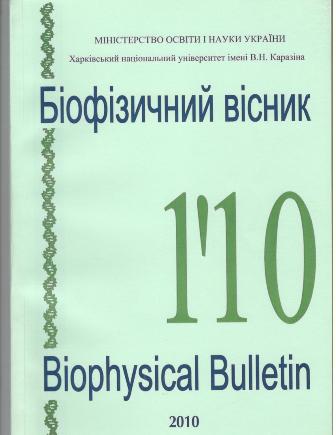The way of modeling of spatials structure of protein on determining it nucleotide sequences
Abstract
The novel way of modeling the spatial structure of a protein in determining its nucleotide sequences is
elaborated. The concept of a configuration of peptide bond as the major coded in genome alongside with
amino acids by the rests, an element of the spatial structure of the protein. The table of a genetic code of the spatial structure of the protein is presented, using which it is possible to construct a structural template of protein, and also to decode the presence and position of fragments of the secondary structure of it. The important advantage of a method is that it is possible to construct a structural pattern individually for any unknown protein only "having read through" determining its nucleotide sequence. The lead comparative analysis of schemes of secondary structure, decoded on nucleotide sequences, and schemes from Protein Data Bank, constructed on the basis of experimental data of spectroscopy of a nuclear magnetic resonance and the roentgen-structural analysis, for α-subunit of hemoglobin, major actinandα-actin 1 testified to greater resolvability (up to 1 amino acids rest), accuracy (100 %), unambiguity (an individual structural pattern) and simplicity of the way of modeling offered in given work.
Downloads
References
2. Anfinsen C.B. Structural basis of ribonuclease activity. FedProc. 1957. V.16.№3. Р.783–791.
3. Карасёв В.А. Генетическийкод: новые горизонты. СПб.: ТЕССА. 2003. 145 с.
4. Карасёв В.А., Лучинин В.В. Введение в конструирование бионических наносистем. М.: Физматлит. 2009. 463 с.
5. Кондратьев М.С., Кабанов А.В., Комаров В.М. Спиралеобразующие конформеры в структурной организации метиламидов N-ацетил-alpha-L-аминокислот. Квантово-химический анализ. Биофизика. Т.52. №3. С.401—408.
6. Crick F. Codon-anticodon pairing: the wobble hypothesis. J. Mol. Biol.1966. V.19. Р.548-555.
7. Соколик В.В. Принципы моделирования 3D-структуры белков-виновников возраст-зависимой конформационной патологии. Клиническая геронтология. 2009. T.15. №8-9. С.119.
8. He Y., Chen Y., Alexander P. et al. NMR structures of two designed proteins with high sequence identity but different fold and function. Proc. Natl. Acad. Sci. USA. 2008. №105. Р. 14412—14417.
9. Илиел Э. Основы стереохимии. М.: ИЦ «Академия». 2008. 464 с.
10. Кушелев А.Ю., Полищук С.Е., Неделько Е.В. и др. Построение масштабной модели структуры белка. Актуальные проблемы современной науки. 2002. №.2(5). С.236—243.
11. Волькенштейн М.В. Конфигурационная статистика полимерных цепей. М.-Л. 1959. 466 с.
12. Jimenez-Montano M.A., Mora-Basanez C.R., Poschel Th. The hypercube structure of the genetic code explains conservative and non-conservative amino acid substitutions in vivo and in vitro. BioSystems. 1996. V.39. Р.117—125.
13. Самченко А. А., Кабанов А. В., Комаров В. М. Бистабильность неплоской формы пептидной группы в структуре дипептидов L-аминокислот. "Математика. Компьютер. Образование". Cб. трудов XIV международной конференции. Под общей редакцией Г.Ю. Ризниченко Ижевск: Научно-издательский центр "Регулярная и хаотическая динамика". 2007. Т. 2. С. 291—304.
Authors who publish with this journal agree to the following terms:
- Authors retain copyright and grant the journal right of first publication with the work simultaneously licensed under a Creative Commons Attribution License that allows others to share the work with an acknowledgement of the work's authorship and initial publication in this journal.
- Authors are able to enter into separate, additional contractual arrangements for the non-exclusive distribution of the journal's published version of the work (e.g., post it to an institutional repository or publish it in a book), with an acknowledgement of its initial publication in this journal.
- Authors are permitted and encouraged to post their work online (e.g., in institutional repositories or on their website) prior to and during the submission process, as it can lead to productive exchanges, as well as earlier and greater citation of published work (See The Effect of Open Access).





